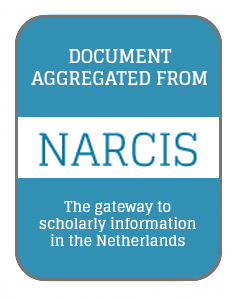Focal point
Location
National Academic Research and Collaborations Information System (NARCIS) is the main Dutch national portal for those looking for information about researchers and their work. NARCIS aggregates data from around 30 institutional repositories. Besides researchers, NARCIS is also used by students, journalists and people working in educational and government institutions as well as the business sector.
NARCIS provides access to scientific information, including (open access) publications from the repositories of all the Dutch universities, KNAW, NWO and a number of research institutes, datasets from some data archives as well as descriptions of research projects, researchers and research institutes.
This means that NARCIS cannot be used as an entry point to access complete overviews of publications of researchers (yet). However, there are more institutions that make all their scientific publications accessible via NARCIS. By doing so, it will become possible to create much more complete publication lists of researchers.
In 2004, the development of NARCIS started as a cooperation project of KNAW Research Information, NWO, VSNU and METIS, as part of the development of services within the DARE programme of SURFfoundation. This project resulted in the NARCIS portal, in which the DAREnet service was incorporated in January 2007. NARCIS has been part of DANS since 2011.
DANS - Data Archiving and Networked Services - is the Netherlands Institute for permanent access to digital research resources. DANS encourages researchers to make their digital research data and related outputs Findable, Accessible, Interoperable and Reusable.
Members:
Resources
Displaying 201 - 205 of 1863New regulations governing land sales in Central and Eastern Europe: Imposing restrictions via particularized institutions?
In response to the expiration of the transitory restrictions imposed on agricultural land acquisitions by foreigners, governments in Central and Eastern Europe have introduced new rules governing land sales transactions. Since direct restrictions on foreign investors would now be illegal under the EU treaties, the desire to preserve the status quo has resulted in limited access to land not only for foreigners but also for some groups of domestic investors. In this study, we analyze land market regulations adopted in Latvia, Poland, Romania, and Slovakia.
Mining water governance : everyday community-mine relationships in the Peruvian Andes
This thesis documents as well as questions how the presence of large mining operations in Andean regions of Peru alters social and natural landscapes. Taking conflicts over water as a useful entry-point for the analysis, it explores and unravels the dilemmas and challenges faced by the main conflicting actors: rural communities and mining companies. Through an in-depth analysis of how the actors navigate these challenges, focusing on those related to water, the thesis sets out to understand what happens with water in contexts of mineral extraction.
The Relation between Large-Scale Land Acquisitions and Rural Households: Evidence from Ethiopia and Tanzania
markdownabstractThe aim of the thesis is to understand the impact of large-scale foreign land acquisitions on rural households. The rapid expansion of large-scale land acquisition (LSLA) by foreign investors in developing countries over the past 10 years has precipitated a heated debate over the impacts on rural households in the recipient regions. LSLA brings often much-needed investment to agriculture in developing countries, potentially raising productivity, and creating rental and labour opportunities from which rural households can benefit.
Estimating the impacts of urban growth on future flood risk: A comparative study
The unprecedented growth of cities has a significant impact on future flood risk that might exceed the impacts of climate change in many metropolitan areas across the world. Although the effects of urbanisation on flood risk are well understood, assessments that include spatially explicit future growth projections are limited. This comparative study provides insight in the long term development of future riverine and pluvial flood risk for 18 fast growing megacities.
Hurricane Harvey Report: A fact-finding effort in the direct aftermath of Hurricane Harvey in the Greater Houston Region
On August 25, 2017, Hurricane Harvey made landfall near Rockport, Texas as a Category 4 hurricane with maximum sustained winds of approximately 200 km/hour. Harvey caused severe damages in coastal Texas due to extreme winds and storm surge, but will go down in history for record-setting rainfall totals and flood-related damages. Across large portions of southeast Texas, rainfall totals during the six-day period between August 25 and 31, 2017 were amongst the highest ever recorded, causing flooding at an unprecedented scale.



